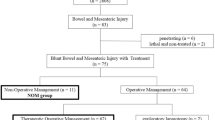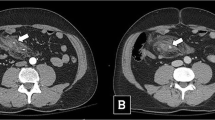Abstract
Background:
The incidence of blunt bowel and mesenteric injury (BBMI) has increased recently in blunt abdominal trauma, possibly due to an increasing number of high-speed motor accidents and the use of seat belts.
Objective:
Our aim was to identify the factors determining the time of surgical intervention and how they affect the outcome of the patient with BBMI. This was achieved by reviewing our experience as a major Victorian trauma service in the management of bowel and mesenteric injuries and comparing this to the experiences reported in the literature.
Methods:
A retrospective study reviewing 278 consecutive patients who presented to the Alfred trauma center with blunt bowel and mesenteric injuries over a 6-year period.
Results:
The patient cohort comprised 278 patients with BBMI (66% were male, 34% were female), of whom 80% underwent a laparotomy, 17% were treated conservatively and 3% were diagnosed post-mortem. In terms of time from admission to laparotomy, 67% were treated within 0–4 h, 9% within 4–8 h, 3% within 8–12 h, 10% within 12–24 h, 4% within 24–48 h and 7% at >48 h. A focused abdominal sonography for trauma (FAST) was performed in 86 patients, of whom 51% had a positive FAST, 44% had a negative FAST and 4% had an equivocal FAST. Overall, 13% of the patient cohort did not have a FAST. Computerized tomography (CT) scans were undertaken preoperatively in 68% of the patients, revealing free gas (22% of patients), bowel-wall thickening (31%), fat and mesenteric stranding or hematoma (38%) and free fluid with no solid organ injury (43%).
Conclusion:
The timing of surgical intervention in cases of BBMI is mostly determined by the clinical examination and the results of the helical CT scan findings. The FAST lacks sensitivity and specificity for identifying bowel and mesenteric trauma. A delayed diagnosis of > 48 h has a significantly higher bowelrelated morbidity but not mortality.
Similar content being viewed by others
References
Elton C, Riaz AA, Young N, Schamschula R, Papadopoulos B, Malka V. Accuracy of computed tomography in the detection of blunt bowel and mesenteric injuries [see comment]. Br J Surg 2005;92:1024–1028.
Chandler CF, Lane JS, Waxman KS. Seatbelt sign following blunt trauma is associated with increased incidence of abdominal injury. Am Surg 1997;63:885–888.
Sokolove PE, Kuppermann N, Holmes JF. Association between the “seat belt sign” and intra-abdominal injury in children with blunt torso trauma. Acad Emerg Med 2005;12:808–813.
Watts DD, Fakhry SM, Group EM-IHVIR. Incidence of hollow viscus injury in blunt trauma: an analysis from 275,557 trauma admissions from the East multi-institutional trial [erratum appears in J Trauma. 2003;54(4):749]. J Trauma 2003;54: 289–294.
Xeropotamos NS, Nousias VE, Ioannou HV, Kappas AM. Mesenteric injury after blunt abdominal trauma. Eur J Surg 2001;167:106–109.
Menegaux F, Tresallet C, Gosgnach M, Nguyen-Thanh Q, Langeron O, Riou B. Diagnosis of bowel and mesenteric injuries in blunt abdominal trauma: a prospective study. Am J Emerg Med 2006;24:19–24.
Richards JR, McGahan JP, Simpson JL, Tabar P. Bowel and mesenteric injury: evaluation with emergency abdominal US. Radiology 1999;211:399–403.
Saku M, Yoshimitsu K, Murakami J, Nakamura Y, Oguri S, Noguchi T, Ayukawa K, Honda H. Small bowel perforation resulting from blunt abdominal trauma: interval change of radiological characteristics. Radiat Med 2006;24:358–364.
Stuhlfaut JW, Soto JA, Lucey BC, Ulrich A, Rathlev NK, Burke PA, Hirsch EF. Blunt abdominal trauma: performance of CT without oral contrast material. Radiology 2004;233:689–694.
Gonzalez RP, Han M, Turk B, Luterman A. Screening for abdominal injury prior to emergent extra-abdominal trauma surgery: a prospective study. J Trauma 2004;57:739–741.
Hughes TMD, Elton C, Hitos K, Perez JV, McDougall PA. Intraabdominal gastrointestinal tract injuries following blunt trauma: the experience of an Australian trauma centre. Injury 2002;33:617–626.
Hackam DJ, Ali J, Jastaniah SS. Effects of other intra-abdominal injuries on the diagnosis, management, and outcome of small bowel trauma. J Trauma 2000;49:606–610.
Brownstein MR, Bunting T, Meyer AA, Fakhry SM. Diagnosis and management of blunt small bowel injury: a survey of the membership of the American Association for the Surgery of Trauma. J Trauma 2000;48:402–407.
Mitsuhide K, Junichi S, Atsushi N, Masakazu D, Shinobu H, Tomohisa E, Hiroshi Y. Computed tomographic scanning and selective laparoscopy in the diagnosis of blunt bowel injury: a prospective study. J Trauma 2005;58:696–701 discussion 701–703.
Dowe MF, Shanmuganathan K, Mirvis SE, Steiner RC, Cooper C. CT findings of mesenteric injury after blunt trauma: implications for surgical intervention. AJR Am J Roentgenol 1997;168:425–428..
Scaglione M, di Castelguidone E, Scialpi M, Merola S, Diettrich AI, Lombardo P, Romano L, Grassi R. Blunt trauma to the gastrointestinal tract and mesentery: is there a role for helical CT in the decision-making process? Eur J Radiol 2004;50:67–73.
Brofman N, Atri M, Hanson JM, Grinblat L, Chughtai T, Brenneman F. Evaluation of bowel and mesenteric blunt trauma with multidetector CT. Radiographics 2006;26:1119–1131.
Fakhry SM, Brownstein M, Watts DD, Baker CC, Oller D. Relatively short diagnostic delays (<8 hours) produce morbidity and mortality in blunt small bowel injury: an analysis of time to operative intervention in 198 patients from a multicenter experience. J Trauma 2000;48:408–414 discussion 405–414.
Rodriguez C, Barone JE, Wilbanks TO, Rha C-K, Miller K. Isolated free fluid on computed tomographic scan in blunt abdominal trauma: a systematic review of incidence and management. J Trauma 2002;53:79–85.
Author information
Authors and Affiliations
Corresponding author
Rights and permissions
About this article
Cite this article
Alsayali, M.M., Atkin, C., Winnett, J. et al. Management of blunt bowel and mesenteric injuries: Experience at the Alfred hospital. Eur J Trauma Emerg Surg 35, 482–488 (2009). https://doi.org/10.1007/s00068-009-8078-4
Received:
Accepted:
Published:
Issue Date:
DOI: https://doi.org/10.1007/s00068-009-8078-4




